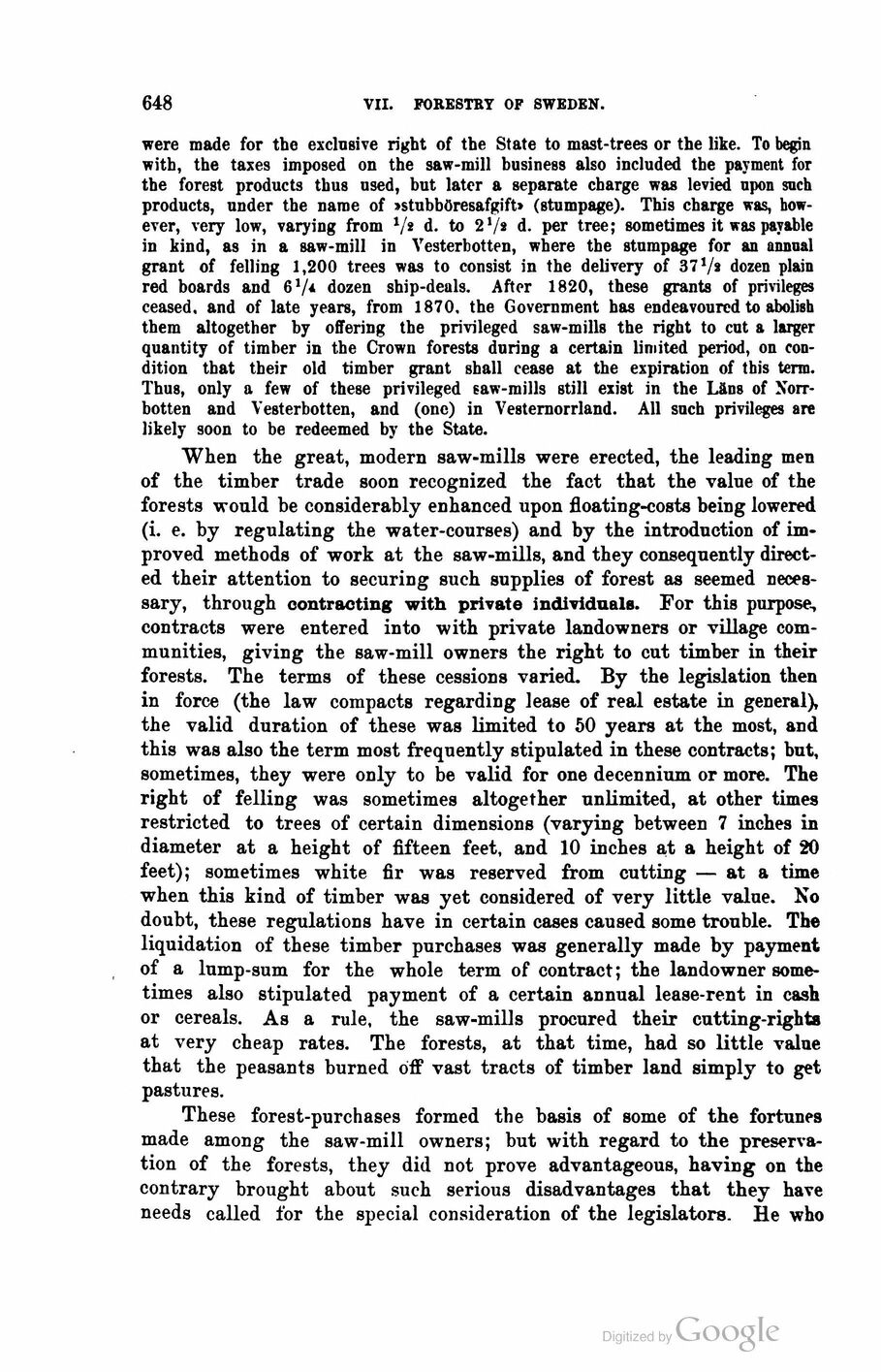
Full resolution (JPEG) - On this page / på denna sida - Second part - VII. Forestry - 2. Forest Industries. By E. Arosenius, Ph. D., Royal Central Bureau of Statistics, Stockholm - Timber Cutting

<< prev. page << föreg. sida << >> nästa sida >> next page >>
Below is the raw OCR text
from the above scanned image.
Do you see an error? Proofread the page now!
Här nedan syns maskintolkade texten från faksimilbilden ovan.
Ser du något fel? Korrekturläs sidan nu!
This page has never been proofread. / Denna sida har aldrig korrekturlästs.
648
VII. FORESTRY OF SWEDEN’.
were made for the exclusive right of the State to mast-trees or the like. To begin
with, the taxes imposed on the saw-mill business also included the payment for
the forest products thus used, but later a separate charge was levied upon such
products, under the name of »stubböresafgift» (stumpage). This charge was,
however, very low, varying from V2 d. to 2’/« d. per tree; sometimes it was payable
in kind, as in a saw-mill in Vesterbotten, where the stumpage for an annual
grant of felling 1,200 trees was to consist in the delivery of 371/t dozen plain
red boards and 61/* dozen ship-deals. After 1820, these grants of privileges
ceased, and of låte years, from 1870, the Government has endeavoured to abolish
them altogether by offering the privileged saw-mills the right to cut a larger
quantity of timber in the Crown forests during a certain limited period, on
condition that their old timber grant shall cease at the expiration of this term.
Thus, only a few of these privileged saw-mills still exist in the Läns of
Norrbotten and Vesterbotten, and (one) in Vesternorrland. All such privileges are
likely soon to be redeemed by the State.
When the great, modern saw-mills were erected, the leading men
of the timber trade soon recognized the fact that the value of the
forests would be considerably enhanced upon floating-costs being lowered
(i. e. by regulating the water-courses) and by the introduction of
improved methods of work at the saw-mills, and they consequently
directed their attention to securing such supplies of forest as seemed
necessary, through contracting with private individuals. For this purpose,
contracts were entered into with private landowners or village
communities, giving the saw-mill owners the right to cut timber in their
forests. The terms of these cessions varied. By the legislation then
in force (the law compacts regarding lease of real estate in general),
the valid duration of these was limited to 50 years at the most, and
this was also the term most frequently stipulated in these contracts; but,
sometimes, they were ODly to be valid for one decennium or more. The
right of felling was sometimes altogether unlimited, at other times
restricted to trees of certain dimensions (varying between 7 inches in
diameter at a height of fifteen feet, and 10 inches at a height of 20
feet); sometimes white fir was reserved from cutting — at a time
when this kind of timber was yet considered of very little value. No
doubt, these regulations have in certain cases caused some trouble. The
liquidation of these timber purchases was generally made by payment
of a lump-sum for the whole term of contract; the landowner
sometimes also stipulated payment of a certain annual lease-rent in cash
or cereals. As a rule, the saw-mills procured their cutting-righta
at very cheap rates. The forests, at that time, had so little value
that the peasants burned off vast tracts of timber land simply to get
pastures.
These forest-purchases formed the basis of some of the fortunes
made among the saw-mill owners; but with regard to the
preservation of the forests, they did not prove advantageous, having on the
contrary brought about such serious disadvantages that they have
needs called for the special consideration of the legislators. He who
<< prev. page << föreg. sida << >> nästa sida >> next page >>